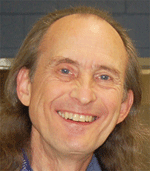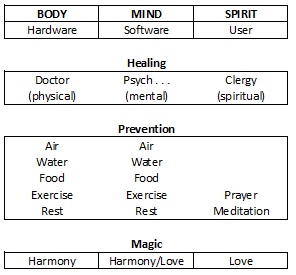In previous issues of Computer Times, we printed a 26-month series from the book titled Get The MOST from Yourself, by Dr. Terry Kibiloski. This is the 13th article of that series.
Creating a Healthy Spirit – Part 1
The human system is similar to the personal computer system, with three major parts – the body (hardware), the mind (software), and the spirit, or soul, (user).
We are spirits having a human experience!
To maintain the human system it’s important to understand:
- Body specialists (doctors) help maintain our human body.
- Mind specialists (psychologists) help maintain our human mind.
- Spirit, or soul, specialists (priests, ministers, rabbis, etc.) teach us how to effectively use our body and mind. The ideal teacher is the Creator of our body and mind.
If you can understand the similarity between the computer system and the human system, you are on your way to getting the MOST from yourself. Let’s now look at some important principles.
- As the computer operator uses the hardware and software to have a computing experience, our spirit uses the body and mind to have a human experience
- Our overall health depends upon a harmonious relationship between our body, mind and spirit
- Our human system seeks harmony and ease, not dis-ease
- We are spirits having a human experience.
Last month, we showed you how to apply the principles of this series to have a healthy mind. This month, we focus on having a healthy spirit.
It is important to understand:
- Each human system responds to pleasure and avoids pain.
Health clubs understand this principle and use it well. They focus on the pleasure of looking good, enjoying life, and being healthy rather than on the pain of exercise.
Notice that the events are the same, they don’t change. What changes is your focus, and your deep desire for the pleasurable outcome. Both are important.
You can change your focus on every event in your life. You no longer diet (pain), you eat healthier (pleasure). You don’t go to work (pain), you challenge yourself to be creative and make a game out of doing things smarter and faster each day (pleasure). You don’t “put up” with the kids (pain), you become a kid again and enjoy them while they’re young (pleasure). Do you see the difference? It’s not what you do, it’s why you do it. You focus on the pleasure.
For example, let’s look at dieting. When we say “I’m going on a diet,” it is usually associated with pain, not pleasure. This is because our focus is on giving up something – our favorite foods and time (for exercising). If you change your focus to the desired outcome, which is being healthy, living a more enjoyable life, fitting into your favorite clothes, more self esteem, etc., you will soon find yourself looking forward to getting fit and being healthy. The more you desire the outcome, the quicker you will make it happen. My personal decision to eat healthy and exercise is driven by the fact that I don’t have time to get sick and be run down. There are too many exciting things to do in life that require good health and energy and I want to be in the best condition possible to enjoy each new adventure.
Tom Sawyer understood the pain/pleasure principle when he got his boyhood friends to paint the fence. He changed their focus and quickly changed their experience from one of pain to one of pleasure. In addition to changing their focus, he also developed such a strong desire for the “pleasurable” experience that they were even willing to pay Tom for the “pleasure” of painting the fence.
There is a story of a disciple who asked his teacher when he would find God. The teacher took the disciple to the lake and held his head under water. After a few minutes, the teacher released him and asked the disciple how he felt. The disciple replied, “I was dying for a breath of air.” The teacher said, “When you feel that intensely for God, then you will find him.” This also holds true when you are trying to make your dreams become a reality. When you feel this intensely for one of your dreams, it is then you will take the actions to make it become a reality.
The power of dreams (thoughts) can have a dramatic effect on our reality. A great example of turning a dream into reality is Walt Disney’s dream of a family theme park. What a wonderful reality we have because of the dream of this one man.
If I had a magic wand and told you I could make any dream come true for you, what would your dreams be?
Take a few minutes and write down your dreams.
Are you ready to make your dreams become reality?
Be aware, you are not limited to a single dream. You can have several, and change them as your interests change. The main thing, though, is to have a dream, or many dreams, and to act on them.
Remember, our spirit controls the mind and, in turn, our mind controls our body. This is important to understand when looking at the power of dreams.
Our dreams (thoughts) are created by our spirit. They are then processed by our mind and acted out with our body. This sequence of events takes place for every major accomplishment in our lives. It is not enough to simply place the mind into a set of behaviors (i.e. a diet program, 10 steps to a new you, etc.), the spirit must be directing the full course of events. This only happens when the “spirit is willing.”
How many times have you started an exercise program, or a diet, or some other steps to a thinner, smarter, or some other you, only to abandon your efforts in just a few days or weeks? Why do you think you quit? I suggest to you, that your spirit was not willing.
We see people try several different methods to quit smoking, or to get fit, or to lose weight, only to abandon them over and over again. Then, something excites their spirit and they instantly change their life by simply throwing the cigarettes away, or becoming fitness addicts, or getting in shape and staying that way the rest of their lives. What finally happened to make such a dramatic change in their lives? The spirit was finally willing!
Once the spirit is willing, and you begin turning your dreams into reality, you need to decide whether you wish to be a duck or an eagle. We use “duck” to symbolize someone who blindly follows the rest of the world like a little duckling follows momma duck, and “eagle” to symbolize someone who soars to the highest peaks in the human experience.
Above my desk is a framed poster with a picture of an eagle. Written in gold letters below the eagle is the statement “Eagles don’t flock – you have to find them one at a time.” While this is true for both the bird and our human eagle, we hope to make the human eagle much easier to find in the future. In fact, we view this book, along with our seminars and tapes, as the breeding ground for eagles.
Inside every one of us who may feel like our symbolic duck there is an eagle waiting to be released. Like the ugly duckling of storybook fame, you simply need to learn how to look at yourself in a new way.
Like the ugly duckling who was already a swan, you are already an eagle. You simply need to realize this and stop acting like a duck. To help you in this analogy, let’s look at a few duck and eagle behaviors.
- Ducks follow the crowds and stand in the longest lines at public places. Eagles soar above the crowds and find the shortest lines.
- Ducks are pessimists. Eagles are optimists.
- Ducks think success comes from following the right crowd. Eagles know success comes from following their own vision.
- Ducks see no further than the duck in front of them. Eagles soar and see the big picture, flying high above the daily obstacles.
- Ducks are consumed with the “quack, quack, quack” of complaining, hoping for their lucky break. Eagles see opportunity everywhere and make their own “luck.”
- Ducks remain on the ground, afraid to follow their dream of flying. Eagles naturally fly and follow much higher dreams.
Do you get the picture? Which are you? An eagle or a duck? Isn’t it time you began living your new life as an eagle, or as an eagle soaring to even greater heights?
So, how do you release that eagle inside of you? Where do you begin? Like the eagle in nature, the only way to fly is to step out of the nest. In the best-seller book of the 1970s, Jonathan Livingston Seagull, Jonathan told Fletch “Don’t believe what your eyes are telling you. All they show is limitation. Look with your understanding (your spirit), find out what you already know, and you’ll see the way to fly.” We’ve heard this advice given in several other ways with words like “Trust your heart” and “Follow your dreams.” But FIRST, you must step out of the nest.
Nests can be places of warmth or places of pain. Both type of nests can offer a sense of stability, a protection from the unknown. Both type of nests can also smother its ducklings. We see children surrounded in love who never leave home, afraid to cut the apron strings, afraid of what lies outside the nest. We see victims of abuse remain in a situation for years, more afraid of what may await them outside the familiar nest. We see people caught up in a nest of their own making, built upon hate and anger. Whatever your nest may be, whether it is a place of smothering love, fear, or anger, you need to step out of it if you want to soar with the eagles.
Your leaving must be of your spirit. You must “look with your understanding (your spirit), find out what you already know, and you’ll see the way to fly.” To successfully fly, you must have unconditional love as your wings. To strengthen your wings, you need unconditional forgiveness. Only then can you really learn how to fly.
Like the eagle in nature, your first few flights may be a little shaky, but before you know it you will begin soaring to new heights.
You can tell an eagle by frequent bursts of smiling. We challenge you to begin experiencing frequent bursts of smiling in your life.
Send this to everyone you consider a FRIEND.
Much more next month . . . Get the Most from Yourself – Chapter 13
IMPORTANT NOTICE: This file is protected by copyright laws. It may not be copied or reproduced in any way without the expressed permission from the author, Dr. Terry Kibiloski. Readers who purchase a copy of this file from Computer Times, may make a printed copy for their personal use only.


